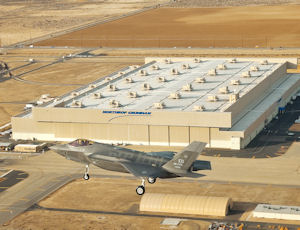Northrop Grumman Aerospace Systems in Palmdale is developing a new automated system to apply coatings to aircraft parts in an effort to save money and reduce the fumes of dangerous chemicals. The system is part of a Northrop Grumman Corp. program to cut greenhouse gases at its 16 aerospace manufacturing facilities by 25 percent by 2014. Northrop has worked with industry and military partners for about five years to develop technology that improves on conventional spraying booths. The aerospace and defense giant is targeting the fourth quarter for getting the system operating. The switch is not as easy as just replacing equipment, as the performance of the multi-million dolllar fighter jets and the safety of the crew must be taken into consideration. “There is a lot of thought going into how we can benefit the environment,” said Cristy Williamson, a manufacturing engineer in Manufacturing Technology Development at the Palmdale facility. Northrop operates assembly and maintenance operations out of two million square feet in Palmdale. The B-2 Spirit stealth bomber and the RQ-4 Global Hawk unmanned aircraft are among the aircraft that have been built at the facility. With 3,000 workers, it is among the largest employers in the Antelope Valley. The coating injections process represents the latest way Northrop is updating its manufacturing process. The Palmdale facility already is using an automated production line to make the fuselage for the F-35 Lightning II in a more efficient, less costly manner. As part of the automated line, the fuselage moves between work stations using automated guide vehicles and a robotic system completes the interior and exterior drilling. The assembly line became active March 2011 and made 22 fuselages that year; Northrop expects to produce 43 this year. New system The injected coating system supports the integrated production line and is expected to help the company meet its 2018 goal of making one fuselage a day. While the Northrop facility is large, it does not have the space to accommodate the number of spray booths needed to meet the production demand, which drove the company to find a new coating process, said Amy Akmal, site representative. Spraying a coating on aircraft parts is a labor intensive process that can take up to two weeks to complete. The automated process injects the coating directly onto the part and the curing time has been cut to two days. The new process is not only a way to avoid investing in new paint booths, but it also reduces the cost of hazardous waste disposal associated with using paint, said Gary Ostrowski, technical fellow, production operations and manufacturing technology. “As we kicked off the greenhouse gas initiative we realized this is a significant contribution to helping that effort, as well,” Ostrowski said. The initiative has a target of eliminating 84,000 metric tons of greenhouse gases such as carbon dioxide that can harm the environment. The automated injection coating process would eliminate 500 metric tons a year. “In the overall goal it sounds small, but a 500 metric ton reduction with one change is huge,” Ostrowski said. Compared with Northrop’s other Southern California facilities Palmdale is not among the worst offenders in emitting greenhouse gases. Facilities in Manhattan Beach and Redondo Beach, which use ovens, and the location in El Segundo with its autoclaves — large heating units that make composite aircraft parts — emit more gas. Therefore at Palmdale, changes will be made to the existing paint spray and sanding booths, process handling equipment, light bulbs and lighting fixtures. “It’s the low hanging fruit that can be addressed,” Ostrowski said. On the automated production line making the F-35 fuselage, for example, television monitors give information on the part being made to cut down on the use of paper. And automated electric vehicles are programmed to take the parts to each station, which cuts down on manually moving them. “When a trigger is switched, it goes to the next station,” said Rhonda Nelson, director of process management and integration. When an aircraft comes in for maintenance, the paint is stripped off with a blasting process using wheat starch. The company soon will start a program to recover precious metals from the paint and reuse them and then use the wheat starch, which adds up to 60,000 pounds a year, in a kiln, Williamson said. “That becomes a fuel source and a total elimination of a hazardous waste,” she added.
